 By Pepper Parr By Pepper Parr
December 8, 2014
BURLINGTON, ON.
Ontario’s Trillium Foundation (OTF) has bailed out Burlington Green to the tune of $375,000 over a five year term.
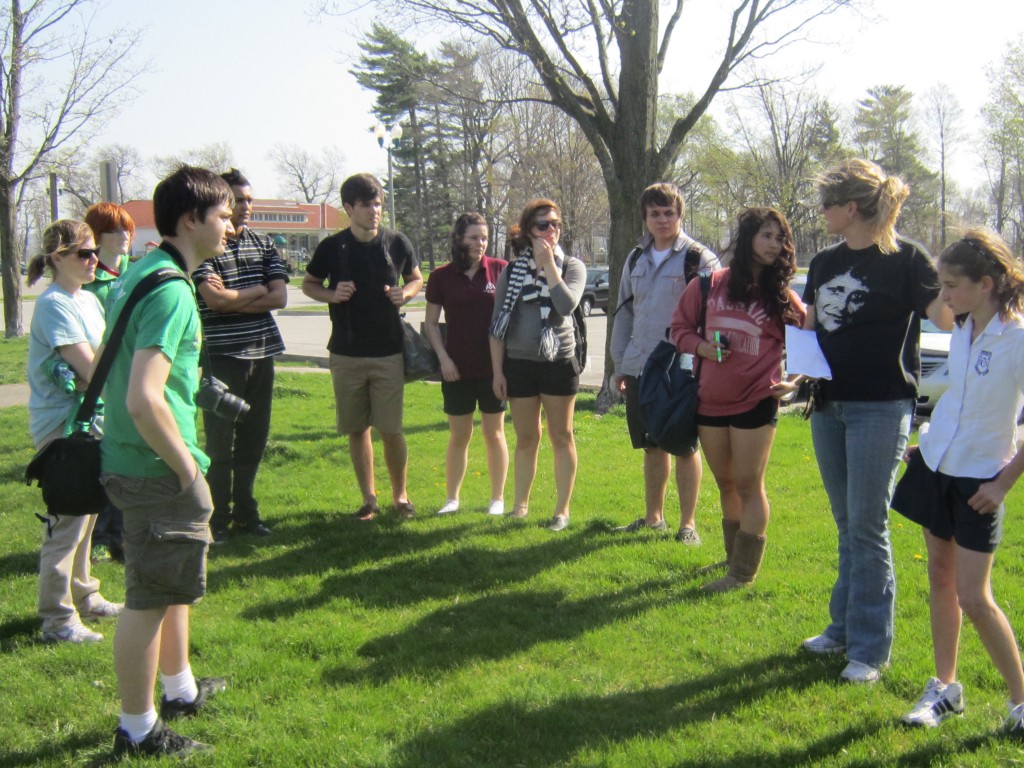 Burlington has led the effort to involve youth in environmental responsibility. The group is about to plant a couple of hundred trees. BurlingtonGreen, a volunteer driven organization striving to make Burlington a healthier more environmentally responsible city, has achieved numerous goals. The OTF grant will support current programming and provide funding to introduce two innovative community-based environmental initiatives.
The grant will fund approximately 50 per cent of the costs to provide a wide range of important environmental programs, services and events.
“Investing in effective, solution focused organizations like BurlingtonGreen is an investment in our collective future. Since their inception in 2007, the agency has engaged thousands of youth, citizens and groups in environmental learning while providing an array of rewarding and impactful volunteer opportunities that have benefited the health of the local environment,” said Eleanor McMahon, MPP for Burlington.
BurlingtonGreen’s Board President Paul Haskins commented on how vital the funding support is in strengthening the agency’s capacity to plan more effectively and strategically for a more sustainable future.
“It has become an increasing challenge for our agency to keep up with the wide range of demands that come our way as pressures on the environment continue to escalate and the implications of climate change become more evident at the local level,” said Haskins.
 BurlingtonGreen Executive Director Amy Schnur with the bike that was donated by the Mountain Equipment Co-op as art of the drive to increase votes for the Call of the Wild $100,000 contest. Grant funds will be used to support the delivery of children and youth programming, to co-ordinate the biennial Youth Eco-Summit and Eco-Awards Celebration, continue their innovative Grow to Give food donation service, to continue to conduct the popular city-wide Clean Up event and habitat restoration project work.
New initiatives include collaborations to create a Burlington focused eco-footprint calculator to help citizens, schools, community groups, and businesses understand their current impacts on the environment, highlighting opportunities to realize positive measurable change as well as efforts to establish a Green Building Demonstration Project.
Burlington took a huge environmental hit in August when rain storms flooded parts of the city and significantly damaged hundreds of homes. Everyone involved in policy in this city now uses the phrase “not if but when” the next environmental disaster strikes but we don’t seem to get much beyond that phrase.
BurlingtonGreen has done a brilliant job of attracting environmental stars to the city and developing a sense of environmental responsibility in the hearts and minds of high school students. Is there a place, an opportunity for BurlingtonGreen to begin the conversation within the community as to how we might protect ourselves and prepare ourselves for that next disaster?
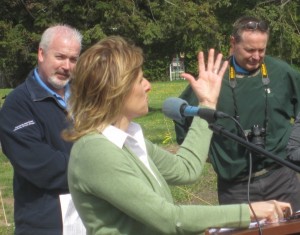 Amy Schnur, current executive director of BurlingtonGreen now has an opportunity to go further with the development of policy proposal and provide some much needed intellectual leadership. Picking up the waste and planting new trees are a major part of being more environmentally responsible and BurlingtonGreen does this well. Now that they have funding in place for the next five years, something very few non-profit organizations are fortunate enough to get; the community can rightfully ask them to step up their game and provide some policy leadership – because it isn`t going to come from city hall, the region or the Conservation Authority.

 By Pepper Parr By Pepper Parr
December 5, 2014
BURLINGTON, ON.
Shelley Raymond had a problem – both her parents were at that point in their lives when they needed a level of care she had not had to provide in the past.
Her Mother’s Alzheimer’s was advanced and her Father’s dementia while stable, made life demanding for her.
Where do they live when they can no longer care for themselves? There is nothing comfortable about the choices people like Shelley Raymond have to make.
 Seniors will represent more than 25% of the population of Burlington in the not too distant future. More than 14% of Canada’s population is over 65 and that number is going to grow – the Baby Boomers are moving into retirement.
Long term care is one option. According the Ms Raymond, a senior today has a 7% chance of getting a long term care bed,
 Will Burlington be properly prepared for the growth in the seniors population? Staying home, alone is the choice many make – but it doesn’t work. The isolation leads to depression; memory loss creates all kinds of problems – medication isn’t taken; repairs on the house just don’t get done; there are challenges with food preparation and falling down stairs or tripping over objects is very common.
Many, including Shelley Raymond believe the province faces a long term care crisis.
Seniors need some level of support for daily living activities – cooking, cleaning, shopping, transportation and medication reminders. Most seniors want to remain independent as long as possible; many try to remain independent and do themselves considerable harm both emotionally and financially.
 A vital and pressing problem for a lot of families in Burlington. Finding the level of care parents need is just one part of the problem – being able to pay for that care is the second part. The over-riding question is – how long will the money last?
What’s available in terms of care? Long term care facilities: $78 a day – $2400 a month for a private room; $56 a day for basic care – $1707 a month.
 Depressing and scary – is this the best the province is going to be able to do? Retirement homes come in at $3500 a month and can run up to $8000 a month with advanced services. These are now growth businesses. The Pearl at Pine is preparing to open seen, the six floor residence on Upper Middle Road next to the Tansley Woods community centre has been open for more than a year and Aldershot has a new retirement community.
The other options are staying in your home or moving in with family.
For those who choose to stay in their homes there is an additional issue and that is home care offered by the province’s Community Care Access Centre (CCAC). There are limits to the number of people they can handle – the number of senior’s that will need care is not as limited. There is a crunch coming.
There are literally tens of thousands of seniors facing this problem – and they are beginning to realize that the government is not going to solve their problem for them. People are coming up with good ideas – that’s what Shelly Raymond had to do when her parents needed care.
Remember that television program The Golden Girls – they are on the way back. Sharing accommodation was an entertaining idea – Shelley Raymond took it a couple of steps further and developed the idea of what she calls “co-housing”.
 Top house was renovated to become a cohouse. Bottom was purpose built to be a cohouse. She created an organization called Solterra that works with people who want to be part of a co-housing property. She looks for properties that can be used, works with architects to build the homes, markets them and then works with owners to get them set up with the services they want and need. Much more information on their web site. Tell Shelly you read about her in the Burlington Gazette.
People share the ownership of a building. Each resident has their own private space and share common space – kitchens, living room and perhaps gardens.
 Floor plan for a six unit cohouse. Typical “co-houses” have four to six owners. Each owner has title to their portion of the house which can be sold on the open market. They share the taxes, the heating and electricity, maintenance.
 The kitchen area of a cohouse in Brechin Ontario There is also the potential to share household services as well – which many of the cohousing operations do. Someone comes in and does the cleaning; some have a person who comes in and does the cooking and meal preparation. There are various levels of service that are possible. The owners decide what they want and can afford.
Most of the units have small walk outs to a private yard in some cases or a common area in others. Parking, transportation – and what about pets.
The basic rule is usually no pets but the owners of the units are the “board of directors” and they can make any decision they like. “One cohousing operation voted to try a pet for a short period of time” explained Raymond. Sally, the dog is now the star of that house and has put in twenty pounds.
The biggest part of co-housing is the “co” part – decisions are made in common and people fashion the kind of community they want.
 Owners bring their own furniture and set up their home the way they want. How does one know that cohousing will work for them? Most of the cohousing organizations have a three month trial period. You move in – you pay “rent” and try it out. If you find that the people are your kind of people and the level of service is what you need – then you can buy your share of the house.
What are the advantages of cohousing? Financially they are incredible. Heating, electricity, taxes, maintenance are all shared by the people living in the home. And those people are not residents – they are the owners. The difference is that they share the ownership of the property. The house is not a nursing home – it belongs to the people who live in it.
They are purchasing a percentage interest in a home, freehold that is individually saleable on the open market, registered on title as Tenants in Common. It is a private residence in which you maintain your privacy and control
The Burlington Community Foundation recently published their third Vital Signs report in which they said “There will be greater emphasis on shifting care to the community and supporting aging in place. Home Care and Community Support Service agencies will support more elderly people with complex and often inter-related health and social care needs to remain in or return to their homes, especially after a hospitalization.
The report suggested Coordinated Care as an approach that will bring together patients, teams of health professionals including specialists, community partners, to ensure not only a positive health outcome but also a quality of life outcome for patients.
If current trends persist, there will continue to be a shortage of long-term care beds and this will result in more seniors staying in their homes out of necessity rather than personal choice and need. The hope is that substantially more spaces in long-term care homes will be created so that waiting lists and wait durations get smaller rather than larger.
 The layout, scope and size of a cohouse is limited only by the imagination of the developers ad the people who want to live in these homes. Neighbourhood planning and building design will take into account the accessibility needs of seniors both in terms of mobility and to reduce the isolation of seniors. This will continue as part of the movement to develop age-friendly communities; something we have not heard very much from the Planning Department.
 This is what cohousing is all about. It is one of the more imaginative and financially viable ideas to come along in some time. And that is exactly where Shelly Raymond is going with her Solterra concept.
When she spoke recently in Burlington there were a number of women in the room who met with her after and asked – “How can we do this now?”

 By Staff By Staff
December 4, 2104
BURLINGTON, ON.
A house ablaze Christmas Day is terrifying – and it happens all too frequently. People are careless, the electrical system is overloaded or something gets bumped off the stove and there is a sudden fire.
The Burlington Fire Department is offering residents some simple fire and life safety tips that will keep families safe during the winter holiday season.
 This is not where fire fighters want to be anytime – and certainly not during the holidays. “This is the time of year when we see an increase in fire-related risks. Many people don’t realize that some decorating materials can be extremely flammable,” said Joe Wintar, chief fire prevention officer. “Consider opting for safer alternatives for lighting like battery operated candles.”
With the arrival of winter weather, residents are reminded to help keep homes and workplaces clear of snow.
“Having unrestricted access to your home in the event of an emergency is very important,” said Wintar. “Clearing snow buildup away from hydrants, house numbers as well as vents on the outside of your home are a just few ways to stay safe during heavy snowfall.”
A fire hydrant in front of one home may protect properties on either side of the street. Wintar says neighbours should consider sharing the responsibility of clearing the hydrant. Residents are also encouraged to ensure house numbers are visible, especially in the rural areas where there can be blowing snow. It’s always advisable to check in on elderly or disabled neighbours to help with snow removal.
Here are few simple tips to follow to keep your home winter-safe:
Ensure the fire hydrant is clearly visible for approaching emergency vehicles and maintain a one metre clearance for firefighter access.
Clear snow away from exterior doors and stairways to allow for a quick and safe emergency exit
Prevent snow and ice from gathering on outside meters to give access for emergency and utility workers.
High and medium-efficiency furnaces and water heaters have vents that exit the building through outside walls rather than through the roof. Keep vents clear, as carbon monoxide can build up inside your home if the vents are blocked.
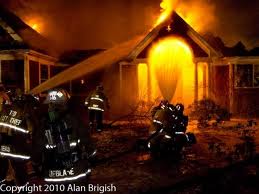 A house on fire on Christmas Day – a true tragedy. Note quite the Twelve Days of Christmas but certainly 12 Days of Holiday Fire Safety tips:
1. Water fresh trees daily.
2. Check all lights before decorating for wear and compatibility.
3. Make sure you have working smoke alarms.
4. Make sure you have working carbon monoxide (CO) alarms; As of Nov. 1, it’s the law.
5. Have, and practice, a fire escape plan so everyone knows how to get out safely.
6. Use extension cords wisely.
7. Give space heaters space, and keep them away from surfaces and anything that could catch fire.
8. Go flameless and use flameless candles.
9. Keep matches and lighters away from children.
10. Keep an eye on your cooking. Stay in the kitchen and pay attention.
11. Ask smokers to smoke outside.
12. Alcohol and fire don’t mix. If you’ve been drinking, avoid smoking and cooking.
The Burlington Fire department wants you and your family to have a happy, safe holiday. They expect Santa to be visiting your home – they do not want to have to visit your home.

 By Pepper Parr By Pepper Parr
December 4, 2014
BURLINGTON, ON
For those parents that use day care – the decisions that have to be made are both emotional and financial.
For many – the cost of day care is close to prohibitive – and then there is the quality of the day care.
News reports of children in day care actually dying – and it does happen – frighten parents. For those with limited incomes the choices are not all that good.
 The joy of watching a child figuring something out – in a safe environment. The province of Ontario has introduced legislation that will provide over sight for unlicensed day care.
The legislation will strengthen oversight of the province’s unlicensed child care sector and increase access to licensed child care options for families. In addition, it will allow the province to immediately shut down a child care provider when a child’s safety is at risk.
The Child Care Modernization Act also:
Gives the province the authority to issue administrative penalties of up to $100,000 per infraction by a child care provider.
Increases the maximum penalty for illegal offences under the act from $2,000 to $250,000.
Increases the number of children a licensed home-based child care provider can care for from five to six.
Clarifies what programs and activities are exempt from licensing requirements, including care provided by relatives, babysitters, nannies and camps that provide programs for school-age children.
Requires all private schools that care for more than five children under the age of four to be licensed as a child care centre.
Amends the Education Act to ensure school boards offer before- and after-school programs for 6 to12 year-olds where there is sufficient demand.
 Activities that keep them busy and learning at the same time. Is this the first step to getting into poker games? The legislation builds on steps that Ontario has already taken to improve oversight of child care. This includes the creation of a dedicated enforcement team to investigate complaints against unlicensed providers, as well as an online searchable registry – paired with a toll-free number – to inquire about unlicensed child care violations.
It is another layer of government that will have to be paid for by the government. There was a time when there was pressure to create a Canada wide day care service with subsidies. The province has a service that started out costing $5 per day per child. Ontario has never flirted with that kind of an idea.
Ontario has 5,069 licensed child care centres in the province with a total capacity of 317,868 spaces; 166,429 of those spaces are in publicly funded schools.
 Keeping them safe and ensuring that they can be outside getting fresh air and exercise is the objective. Keeping the costs bearable is the challenge. Starting in 2014-15, the government is investing an additional $33.6 million, over three years, to support the ongoing operation and modernization of the child care system –protecting the gains made through the previously announced investment of $346 million over four years.
Additional information:
Four steps to finding the right child care

 By Staff By Staff
December 2, 2014
BURLINGTON, ON.
Watch sculpting master Michael Muli use various techniques to transform ice into art at the Royal Botanical Gardens.
 A master ice sculptor will be at the Royal Botanical Gardens December 6thand 7th. No to be missed. Michael is creating an enormous 3D tribute to the RBG Train Show for kids to climb aboard. You can drop by and get your picture taken with the kids.
Be sure to stop by and get your photo taken with the final piece before it disappears!
Event takes place from December 6 (1 p.m. to 5:30 p.m.); December 7 (10 a.m. to 4 p.m.)

 By Staff By Staff
November 28, 2014
BURLINGTON, ON.
Are you a teen in the Halton Region who would like to understand more about the Police, Ethnicity and Culture (PEACE) in our communities?
Are you interested in a career in policing?
Have you ever wondered what the police do, how they prevent and investigate crimes and what the different units within the service are responsible for?
Would you like to have hands-on practical experience of what it’s like to be a police officer?
 If you are 15 – 18 years old and the answers to these questions are yes, maybe you’d like to check out the Halton Regional Police PEACE program! If you are 15 – 18 years old and the answers to these questions are yes, maybe you’d like to check out the Halton Regional Police PEACE program!
There are still spots available for the Winter Police Ethnic and Cultural Education (PEACE) program, which runs from 6:30 – 9:00 pm every Tuesday night for twelve weeks, starting January 20, 2015 and April 7, 2015.
Each week, students will be given presentations by the different units and bureaus within the police service, with the emphasis being on practical demonstration and involvement. As well, students will learn about cultural awareness and inclusion, how the police service strives to provide equitable service for all communities within our Region and how we are educating new Canadians and recent immigrants about policing in Canada.
You can find out more about this free, voluntary program by visiting our website and clicking on Diversity.
Just complete the application form on line and Email it to the Diversity Coordinator at the contact information on the form.

 By Staff By Staff
November 25, 2014
BURLINGTON, ON.
 Bring your pen and pad, come with some ideas or just ready to write. Bring your pen and pad, come with some ideas or just ready to write.
Prompts will be provided, sharing is requested, but not mandatory.
All writing styles welcome, ages 12 and up.
This workshop is provided for FREE, but donations are accepted.
Thursday – Tansley Woods Library 7-9

 By Pepper Parr By Pepper Parr
November 24, 2014
BURLINGTON, ON.
He left us on this day in 1807. Sometime after his community transported his remains to Brantford where he is celebrated and revered.
Burlington was the location of the land grant Joseph Brant was given for his service to the British Army during the American Revolutionary wars.
 Joseph Brant was a part of making Canada what it is today – he just isn’t adequately recognized for his contribution. The city is littered with the history of the land transfers that piece by piece transferred every acre from Joseph Brant to other people in Burlington. The Kerns family was the first to buy property from Brant – 200 acres on the east side of Brant Street.
Each August the city holds an event at the LaSalle Park and Joseph Brant does get a mention.
The Board of the Brant Museum on Lakeshore Road has elaborate plans for a modern display telling the Brant story and the copy of the original Brant home will be part of the structure but the public won’t be able to actually go into the building – that will be used for “administrative” purposes.
 Architect’s rendering of what a “new” Joseph Brant Museum might look like. It would be built on an intersection that will become one of the busiest in the city when the re-developed hospital opens in 2018/19 Poor Joseph Brant – we keep short selling the man and his exceptionally significant achievements.
There is hope. Rick Wilson, the man who corrected a major error in historical fact when he pointed out that an historical sign on the Burlington Heights side of Burlington Bay was incorrect when it described a War of 1812 battle.
That error got corrected and there is now a piece of signage that sets that story straight. Wilson has some thoughts that he hopes will result in the creation and erection of a suitable statue of Brant.
There is hope.
Related stories:
Citizen finally gets the province to recognize their error.
Signage goes up telling the true story of the Burlington Races.

 By Pepper Parr By Pepper Parr
November 24, 2014
BURLINGTON, ON
It was a four event opening at the Art Gallery of Burlington as well as the announcement that Christopher Reid Flock had won the very prestigious Winnifred Shantz ceramics award for his recent ceramic work.
 Christopher Reid Flock’s award winning ceramic. Flock has been reinterpreting the root of functional objects, focusing on aesthetic contrasts and parallels between Japanese and Canadian cultural history. By exploring scale, colour and the integration of mixed media, his works have evolved into free-form shapes and sculptural constructions that evoke recognizable and classic references of traditional Japanese Ikebana arrangements and kimono-wrapping while combining aspects of western industrialization.
The Clay & Glass presents these awards to practicing early career artists who have worked professionally for fewer than 10 years prior to the date of application. The Award is intended to allow the artists to undertake a period of independent research or other activities with the goal of advancing their artistic and professional practice at a key moment in the artist’s career.
Flock began working with clay when he was 23 at the then Burlington Arts Centre. He began his career as a student studying violin and came to the realization that clay was his medium and the violin became a thing of the past.
Denis Longchamps, Director of Program for the AGB was like a proud parent when he made the announcement at the opening Sunday afternoon.
The piece that won the award is on display at the former Fireside Gallery.
 Debra Kuzyk’s ceramic skunk The four openings included Scavengers, Scoundrels and Urban Vermin; a collection of Debra Kuzyk’s ceramic work; the photography of Janusz Wrobel; the monochromatic watercolour abstractions of Warren Hoyano and the display of the award winning Flock ceramic.
Janusz Wrobel was once loaned a camera and given a couple of rolls of film, the current state of that journey was on the walls of the AGB and called “An Aqueous State”
 Janusz Wrobel : “Sweet Water Sea” Wrobel said he wasn’t trying to communicate anything specific with this exhibit but adds that he “came to believe that in our civilization, environmental predicaments could be effectively addressed only by a change of mindset by a vast majority of us.”
The locale for the photographs in this exhibit is Georgian Bay; the work of Tom Thomson and the Group of Seven are an admitted influence.
Warren Hoyano is on the other side of the Lee Chin Family Gallery.
The decision to put the two artists in the same gallery was a curatorial stretch on the part of AGB Director of Program, Dennis Longchamps and yet it works. Moving from the side of the room where Wrobel’s “Evening Amber” is displayed and crossing over – some 30 feet, to where Hoyano’s “Ache” is displayed is certainly a jump.
Not a startling one – but not one you expected to make. It isn’t jarring – but it does stretch you and that is part of what art is supposed to do for us.
In the “This Pocket of Deeds”, Hoyano, a self-taught artists, explores a known shape, the heart and overlaps it with script and gestural marks.
 One piece from the Warren Hoyano, “This Pocket of Deeds exhibit at the Art Gallery of Burlington While love is often associated with the heart shape, Hoyano chose “Void” to engage the viewer on a different trajectory.
Both artists are on display at the AGB until January 25th.

 By Staff By Staff
November 19, 2014
BURLINGTON, ON
No one ever went wrong talking about energy saving – especially when the temperature outside was double digit below and when our friends in Buffalo were getting more than two feet of snow.
Burlington’s Sustainable Development Committee will host a free event on Nov. 25 for homeowners to help reduce home energy costs.
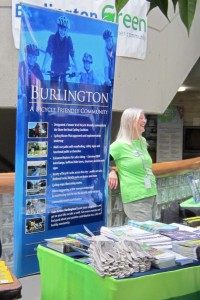 Lynn Robichaud, the city’s senior sustainability coordinator takes part in almost every environmental event in the city – heading up the energy efficiency seminar later this month. Takes place Tuesday, Nov. 25 from 7 p.m. to 9 p.m. at the Burlington Public Library, Central Branch, at 2331 New St.
“Homeowners can learn valuable cost-saving tips to make their home more energy-efficient,” said Lynn Robichaud, the city’s senior sustainability coordinator. “Industry experts will be on hand to answer questions.”
Participating organizations include: Burlington Hydro, GreenVenture, Halton Region, Philips Lighting and Union Gas.
In 1990, the City of Burlington declared itself a Sustainable Development Community and set up the Sustainable Development Committee as an advisory body to City Council.
The role of this volunteer citizens’ committee, which includes members of the public and the business community, is to get people talking about sustainable development and to integrate economic and environmental planning at the municipal level.

 By Pepper Parr By Pepper Parr
November 18, 2014
BURLINGTON, ON.
We did elect them – well 34. 14 % of us did. In twelve days the newly elected council will get sworn in and determine what they want to achieve in the next four years.
 Full team was returned to office. Now they need to get down to work. Long list of tasks and opportunities. Now that the significant seven have all been returned to office – what do they have on their plates for the immediate future and perhaps for the length of their term of office which officially starts December 1 when they are all sworn in. A stronger sense of enthusiasm and drive would be nice
Mayor Goldring explained to us during the election campaign that his first term was a “cleanup/setup” operation. He didn’t explain what he had cleaned up and he hasn’t clarified yet what he means by “set up”. We wait to hear that story.
A partial list of the issues facing this Council includes:
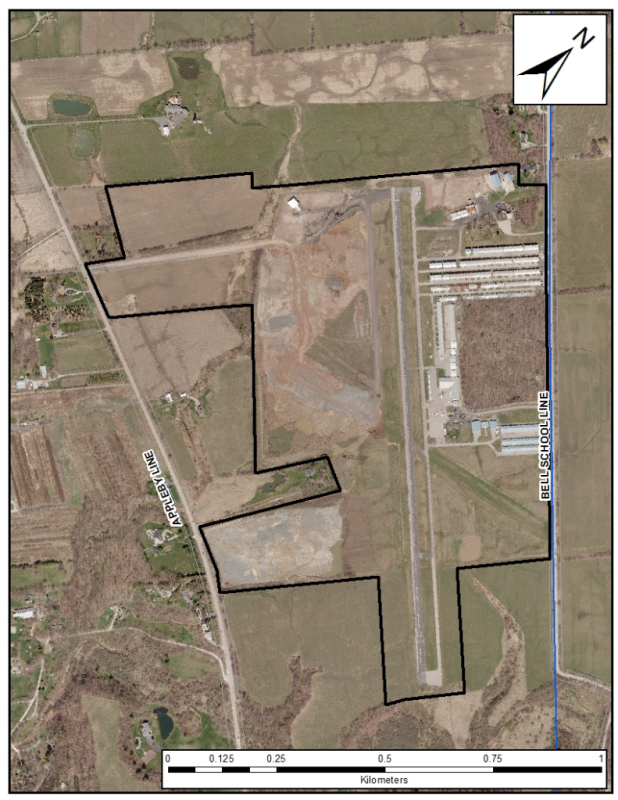 The city now has a site plan application. Will they approve what has been submitted and provide a permit? Air Park – what does the city want to do with it? The city now has a site plan application in hand. Once it is reviewed they will decide if a permit should be issued. Bu what is the long term plan for the air park and is the city going to be able to get the cooperation it needs from Rossi?
Beachway – while the homes in that part of the city – just to the west of Spencer Smith Park are not about to be expropriated – city hall is reported to be beavering away at plans and designs that will come forward at some point in this term of office. One wonders when the public will be invited to the planning
Downtown development: Always an issue in Burlington – which in itself is telling. When we get a downtown one wonders if we will recognize it.
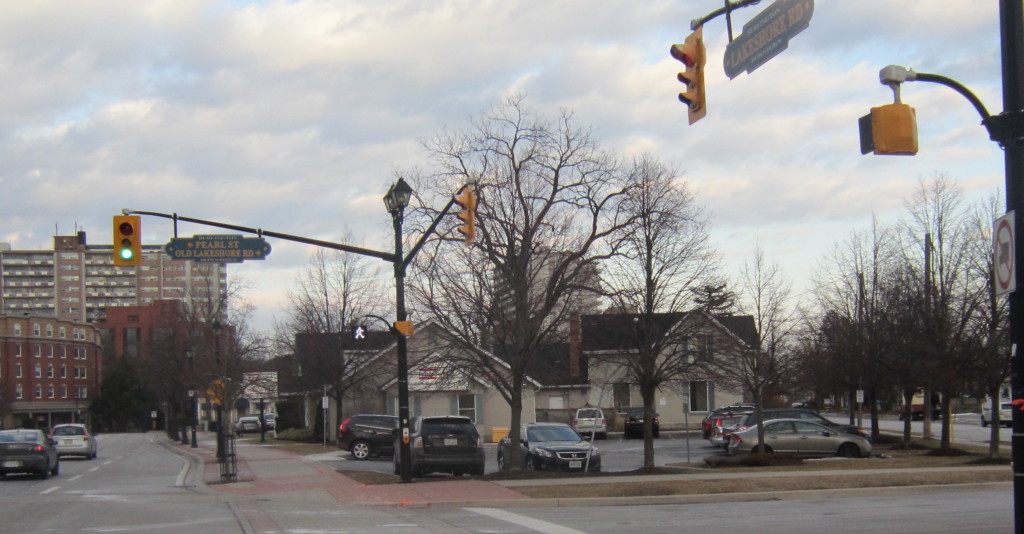 Major development opportunity in the Old LAkeshore precinct. Huge developments underway. How will it all play out during this term of office. Old Lakeshore precinct – sometime this year work will start on the Bridgewater project that is to consist of a 22 storey condo, a seven story condo and an eight storey hotel. The hotel was to be open for the Pan Am Games but that won’t happen. Is there any thinking being done as to what the long term vision is for the properties between Lakeshore Road and Old Lakeshore Road and that part of the waterfront?
Ranked voting: Mayor Goldring kind of liked that idea. Let’s see when he moves to bring it forward now that the province has said it is to be permitted. The only member of the current Council who would have been impacted by Ranked Voting would have been Blair Lancaster – but if you look at who placed second and third – Lancaster suddenly doesn’t look all that bad.
Size of Council. Sometime during this term of office the Regional government will realign its seats and probably give more to Milton. That “might” mean a change in the number of seats Burlington has on the Regional Council. Right now Burlington has seven regional seats which makes every City Council member a Regional Council member as well. Half of a Council member’s income is paid by the Region
Governance: The Council whose term ends the morning of December 1st developed a good approach to Governance and devoted one meeting every quarter to looking and talking about the way they were running the city. There was some very productive work done at those meetings – let’s hope they are continued.
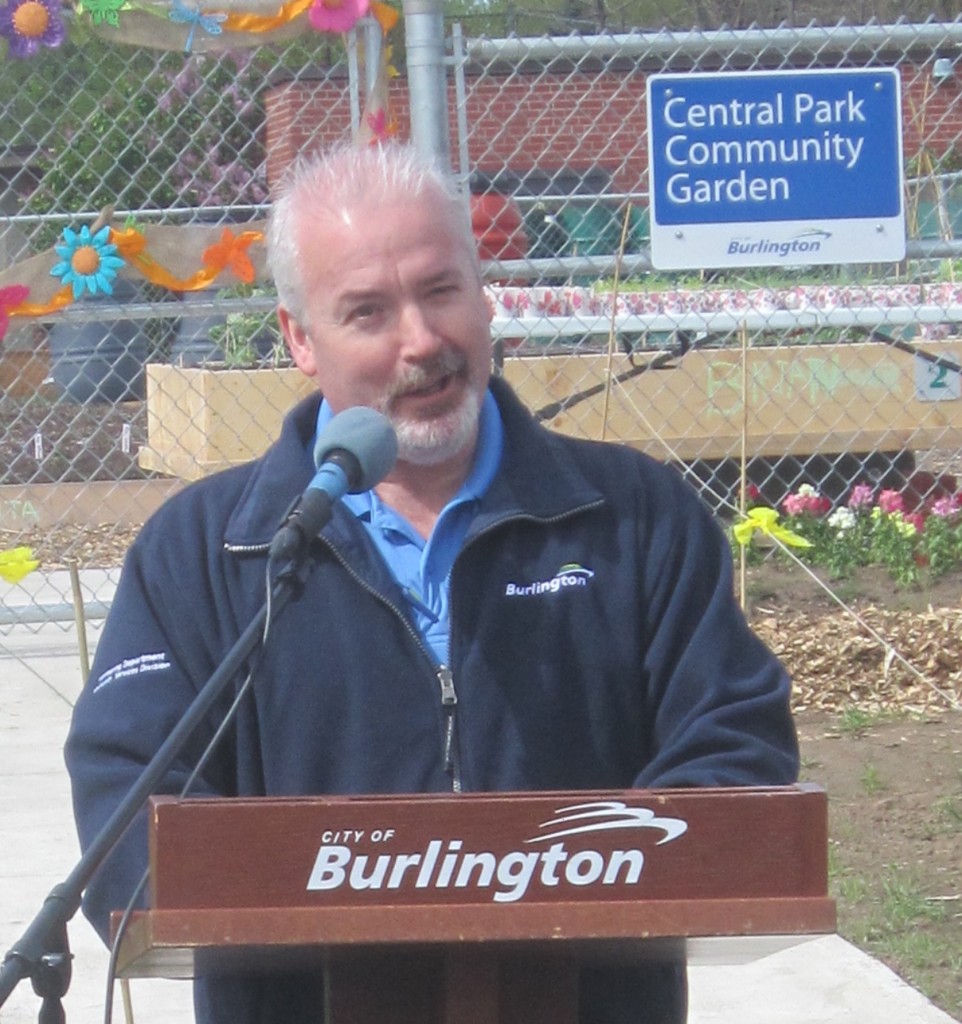 Does current City General Manager Scott Stewart have a change in the title on his business card in the works – or will the moving trucks be getting a call. Scott has kept the city running for the past six months.
A new city manager and an overhaul of the senior ranks. The task of hiring a new city manager is underway. Burlington is seen as one of the better city’s to run and we will be a popular choice for some of the better people out there. The last time this city hired a new City Manager they brought in Jeff Fielding from London who was energetic and had more new projects going than staff could keep up with. His decision to head for what he thought were greener pastures in Calgary put a lot of new ideas into a tail spin and staff had to scramble to work without the drive and focus Fielding brought to everything he did.
He fortunately had Scott Stewart beside him to execute on most of the ideas. Stewart was in the running for the job of City Manager last time and has his hat in the ring this time around as well. If Stewart doesn’t get the nod this time – you can expect him to be making an appointment with a moving company. The guy has been holding the city together for the past three months.
Citizen Engagement. Engaging the community is theoretically what every city hall is supposed to do. Burlington didn’t do all that well on that level. When Cam Jackson asked the late John Boich and former Mayor Walter Mulkewich to lead research into just what was needed to better engage the people who pick up the tab, few expected the report that was produced. Shape Burlington shook up many at city hall who felt they were unfairly picked on which was quite telling.
Some of the senior staff at the time felt they knew what the public needed and that the public didn’t need to be engaged all that much.
When the Shape Burlington report was released there was some hope – but a closer look at the people who served on that committee was revealing – Paul Sharman and Blair Lancaster were on the Shape Burlington Committee and withdrew when they decided to run for office. They were certainly not champions of involving the public during their first term of office but both got re-elected.
Code of conduct: While the Mayor likes to talk about how well this Council functions – in truth it doesn’t function all that well. The Councillors for wards 1 and 2 can’t stand each other – which makes it awkward for them because they sit beside each other.
Councillor Taylor, because of his experience, has a vision of the city and where he thinks it should go that is quite different than that of his colleague ward 4 Councillor Jack Dennison who has served more than 20 years on Council.
These two old timers (that’s intended as a compliment) never did share a common view of the city and the direction it should take. Taylor tends to work from strongly held principles – for Dennison its all about business.
One would like to think they would serve as the institutional memory for Council and while they both know where all the skeletons are buried they seldom put forward much in the way of long term thinking for the city. Councillor Taylor has done some excellent work with his Mt Nemo initiative but that has yet to bear any fruit. The city is spending $200,000 to determine if a heritage district is worthwhile.
Water Street property. This Council is going to have to make a decision soon on just what they will actually do with that stretch of property between St. Paul and Market Streets. They did vote in principal to sell the property subject to the price to be paid and some legal questions that have to be resolved.
Mike Swartz, spokesperson for the other two property owners, commissioned a report on the evolution of the property including the arrangements that were made for the building of the breakwater and the infill that was put in place to prevent natural erosion.
The report includes the Swartz version of the legal arguments that hound this issue. A concern for many is that the report Swartz commissioned will be used by Council to justify their original decision but because it is legal in nature the city’s solicitor might advise that it be kept under wraps. It would appear that the document is certainly germane to the issue – it should be made public if it informs the debate.
The citizen based Waterfront Committee has taken issue with how this matter has been handled and asked for an investigation on the way the city handled this issue. The Municipal Act allows for any person to request that an investigation be undertaken respecting whether a municipality, local board, or a committee of either, has complied with the closed meeting rules contained within section 239 of the Act. Municipalities are able to appoint an Investigator for the purpose of examining these closed meeting complaints.
A request was made last June – at this point the city Clerk’s office said they have yet to get the report. Might be a can of worms with this one
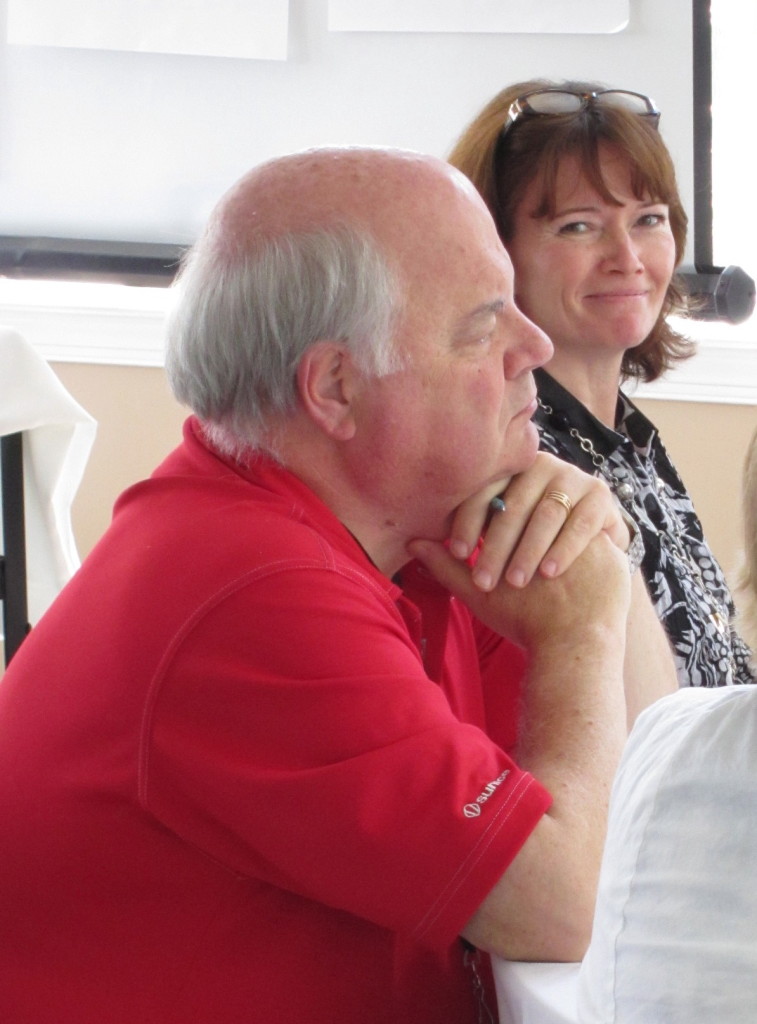 Georgina Black got Burlington to the point where it produced the best Strategic Plan possible under the circumstances. Will Council now move forward with a plan that has both a vision and drive? Strategic Plan. The city put together a pretty good Strategic Plan in 2011. It was limited mostly because of the inexperience of the Council at that time. Given that it will be the same tribe creating the Strategic Plan for the next four years we can expect a shorter time frame to get the document done and a better final document.
Georgina Black of KPMG led Council through the 11 half day exercise. She realized part way through the second session with a group that consisted of both senior staff and council that there wasn’t what she called a BHAG – a big hairy audacious goal – something the city wanted to do.
Burlington doesn’t have a vision; it doesn’t have a goal – what it does have is many groups with goals of their own but nothing that the city can get a grip on and work towards.
Mayor Goldring did make an effort in the first half of his first mandate to pull people together and figure out what we wanted to be when we grew up. That event was as close to a disaster as you can get without being called a failure. The Mayor never produced a report for an event that came in at $50,000. It was all private sector money.
Official Plan: A critical document for the city. Frequently a bit of a yawn – not this time. Burlingtonians are demanding that we have a plan that we stick to and not change at every developers whim
Outstanding Development: Eagle Heights in Aldershot; Tremaine and Dundas in the north east end and Upper Middle Road at Burloak in the east centre part of town. All three are major development opportunities.
Economic Development: Where are we on this file? What defines us? Have we created a niche – something are better at than others and are thus attractive to corporations looking for a new location. Have we gotten beyond that tired phrase: the best mid-sized city in Canada?
This is a lot to get done in a four year term. Does this Council have the drive, vision and fortitude to achieve any of it?

 By Walter Mulkewich By Walter Mulkewich
November 18th, 2014
BURLINGTON, ON
Greg Sorbara, “The Battlefield of Ontario Politics, An Autobiography”, Dundurn Publishers, Toronto, 2014
Greg Sorbara was one of Ontario’s most influential provincial politicians for 27 years from 1985 to 2012: He was a significant cabinet minister in the governments of David Peterson and Dalton McGuinty, including Minster of Finance in the McGuinty government. As President of the Liberal Party of Ontario and Chair of three consecutive Liberal Party election campaign victories, he helped build a successful political machine in Ontario.
 He was in Burlington Monday night as part of his book tour and demonstrated with his straight and candid talk why he was successful and progressive politician. He was in Burlington Monday night as part of his book tour and demonstrated with his straight and candid talk why he was successful and progressive politician.
Sorbara’s autobiography provides a useful summary of Ontario provincial political issues in the past quarter century. But, most significantly this book gives a candid view of how politicians play the political game to actually get things done.
It’s a good read for aspiring politicians, those who want to understated what happens in the back rooms of political parties, and for all of us to understand how politics works.
He gives an understandable account of how the Ontario Health Premium was developed even though his party campaigned on a promise of no tax increase. He explains the kind of deal making that made possible the York Subway expansion. He shows the kind of collaboration that was needed to develop a progressive Ontario Child benefit.
Sorbara deals with the reality of politics as team sport: His candidacy for the Ontario Liberal Party leadership in 1992 in which he came third. His private views on issues such as the harmonized HST and Meech Lake. An honest account of his resignation from the Cabinet over allegations with respect to the Royal Technologies affair, he was exonerated and returned to cabinet. Some interesting stories about candidate recruitment and how campaigns are organized
Perhaps his most controversial chapter is about the gas plant issues in Oakville and Mississauga that he calls “the gas plant myths”, which were “impervious to evidence”. He devoted much of his talk in Burlington to this topic and makes a convincing case, but his is a point of view some might challenge.
His last chapter is the most interesting. He reflects on the future. He expresses his concern about income inequality and he makes a strong case for a national Income Support System and tax reform, as well as federal investment in cities. He talks about the need to grow the economies of smaller cities outside the GTA.
Perhaps Sorbara’s most interesting and controversial suggestion is that, while the Catholic School system has served its purpose, Ontario is changing, and we should have one publicly funded educational system. But, this is a position he never championed in his time at Queens Park.
As the pragmatic practitioner of the political arts, he does not indicate how we might move the political system to accomplish a single public educational system or his other ideas in his last chapter. Maybe that is the point of his book, that there is a time and place for taking on issues.
 Walter Mulkewich is former Mayor of Burlington. He served from 1991 to 1997. Prior to that he was a member of city Council in Burlington and Halton Regional Council. Walter Mulkewich is former Mayor of Burlington. He served from 1991 to 1997. Prior to that he was a member of city Council in Burlington and Halton Regional Council.

 By Pepper Parr By Pepper Parr
November 15, 2014
BURLINGTON, ON.
The 2015 budget will take a significantly different approach in the way it is presented to the public. There will be a focus on Results Based Accountability with the service delivered more easily identified and understood. Tax payers will see the service; its cost and who is responsible for delivering that service efficiently and effectively. The first step in getting to that point was to create an inventory of services delivered to the public and to place them in categories for administrative purposes. What the city actually does for you is set out below.
What has city hall done for you lately? How about changing that to – what does city hall do for you anyway? And for that there is an answer.
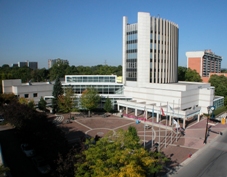 Just under 1000 people working full and part time deliver 25 different services to the public. The building they work in can no longer hold them all. They call it their Portfolio of Services – which is a list of all the things the city does for you. Burlington has what city hall calls an Insight Panel – which is a group of people who answer questions the city poses on the development of a service or a policy. It is a relatively small group of people but it does serve as a good sampling – it includes the balance needed to include gender, location, income, education, home owner or renter. The important part is the city doesn’t know and never will know who you are – they just know what you are.
The city used the Insight Panel to ask some questions about the portfolio of services. It wanted to know how well people understood the names given to the service and the description of the service.
The information being gathered is the first step towards Service Based Budgeting and Results Based Accountability.
The city will assign responsibility for the efficient and within budget delivery of each service and in time will ask the public if they want to continue spending a specific percentage of the budget and a set dollar amount on a specific service.
The following is a list of the services the city delivers.
Building Code Permit & Inspection Service
Development Review Service
Parks & Open Space Design & Development Service
Cultural Service
Organized Sport Support Service
Recreation Service
Council & Citizen Committee Service
Service Burlington
Cemetery Service
Parks & Open Space Maintenance Service
Roads & Sidewalk Maintenance Service
Street Lighting Service
Surface Water Drainage Service
Tree Management Service
Animal Control Service
By-Law Enforcement Service
Emergency Management Service
Fire Protection Service
Halton Court Service
Roads & Structures – Design & Construction Service
Parking Management Service
Traffic Operations Service
Transit Service
Transportation Planning Service
Winter Control Service
Each of these services will be put into a category – the city wanted to know what the panel thought about the six categories they had created and if a specific service should be in a particular category.
674 people were invited to take part in the survey; 385 started and 252 completed what was a long and at times complex survey.
In the report summary staff reported:
What We Learned
• Providing a visual reference, such as a picture, helps the public identify with a service; however, it is important the pictures truly represent the service to avoid confusion.
• The word “service” is over used and redundant.
• Descriptions must be clear and use easy-to-understand language.
• Categories must be well defined and their use must be clear.
What We Will Do
• Work with our service owners and communications partners to identify the appropriate pictures to associate with the service.
• Eliminate the word “service” from the service name.
• Work with our service owners to ensure clear and use easy-to-understand language is used in the descriptions and in other information related to the services.
• Use the comments from the panel to prompt discussion with service owners to refine our services.
• Revisit the category names and the categorization to refine based on feedback.
Of those who completed the survey the city wanted them to comment on the following:
Clarity: There were more favourable comments than unfavourable comments; that is, 70% were favourable and 30% were unfavourable. Of the favourable comments, 42% referred to the overall view being easy to follow.
Of the 30% unfavourable comments, the majority of these comments reflected the redundant use of the word “service” and the lack of clarity in the category names representing the services.
Format: There were more unfavourable comments than favourable comments; that is, 73% were unfavourable and 27% were favourable. Of the unfavourable comments, 28% related to the font size (e.g. being too small) and 20% referred to the need for the visual to be more appealing.
Completeness: There were only unfavourable comments related to completeness. The majority of the comments related to the catalogue not being complete with all services including reference to services provided by the Region of Halton.
Six categories were created with like services clustered together in a single category.
1) Design and Build; 2)Maintenance; 3)Roads and Transportation; 4)Leisure; 5)Local government support; 6) Public Safety and asked if a service belonged in a specific category.
Design & Build Category
Building Code Permit & Inspection Service: Over 70% of the respondents indicated the name and description were suitable. When asked to place the service into a category, over 75% of respondents selected the Design & Build category.
Development Review Service: Less than 50% of respondents indicated the name was suitable and slightly more than 55% of respondents indicated the description was suitable. When asked to place the service into a category, over 75% of respondents selected the Design & Build category.
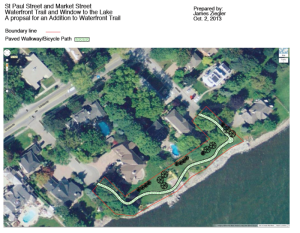 This is a little park that the public may never see – staff thought the city should lease the land on the edge of the lake between Market and St. Paul streets – council has decided to sell it – but that’s not a done deal yet. Parks & Open Space Design & Development Service: More than 60% of respondents indicated the name was suitable and slightly more than 55% of respondents indicated the description was suitable. When asked to place the service into a category, over 60% of respondents selected the Design & Build category.
Leisure Category
Cultural Service: Less than 50% of respondents indicated the name was suitable and less than 60% of respondents indicated the description was suitable. When asked to place the service into a category, over 75% of respondents selected the Leisure category. Seven respondents made specific comments that the Cultural Service name was too vague.
Organized Sport Support Service: Slightly less than 65% of respondents indicated the name was suitable and slightly more than 65% of respondents indicated the description was suitable. When asked to place the service into a category, over 90% of respondents selected the Leisure category.
Recreation Service: 75% of respondents indicated the name was suitable and more than 70% of respondents indicated the description was suitable. When asked to place the service into a category, over 80% of respondents selected the Leisure category.
Local Government Support Category
Council & Citizen Committee Service: Slightly less than 60% of respondents indicated the name was suitable and slightly less than 65% of respondents indicated the description was suitable. When asked to
 Residents gather to review a budget that the city has basically already made up their mind about. Some want a more open, transparent budget process. Results Based Accountability could be a first step towards this happening. place the service into a category, over 90% of respondents selected the Local Government Support category. Six respondents made comments indicating the service description should highlight citizen committees.
Service Burlington: Slightly less than 55% of respondents indicated the name was suitable and only 40% of respondents indicated the description was suitable. When asked to place the service into a category, over 75% of respondents selected the Local Government Support category. Thirteen respondents made specific comments indicating the name and description were too vague.
Maintenance Category
Cemetery Service: Over 70% of respondents indicated the name and description were suitable. When asked to place the service into a category, fewer than 40% of respondents selected the Maintenance category and almost 35% indicated that it did not fit into a category. Five respondents made comments indicating Cemetery Service does not fit well into a category.
Parks & Open Space Maintenance Service: Over 75% of respondents indicated the name and description were suitable. When asked to place the service into a category, over 75% of respondents selected the Maintenance category.
 That’s certainly surface water drainage. Roads & Sidewalk Maintenance Service: Over 75% of respondents indicated the name and description were suitable. When asked to place the service into a category, 60% of respondents selected the Maintenance category, while over 30% selected the Roads & Transportation category.
Street Lighting Service: Over 80% of respondents indicated the name and description were suitable. When asked to place the service into a category, 50% of respondents selected the Maintenance category while over 35% of respondents selected the Roads & Transportation category.
Surface Water Drainage Service: 75% of respondents indicated the name was suitable and over 70% of respondents indicated the description was suitable. When asked to place the service into a category, over 70% of respondents selected the Maintenance category. Three respondents made specific comments indicating the description was unclear.
Tree Management Service: Over 75% of respondents indicated the name and description were suitable. When asked to place the service into a category, over 85% of respondents selected the Maintenance category. Three respondents made specific comments indicating the name should be more descriptive and include the loose leaf pick-up program.
Public Safety Category:
Animal Control Service: Over 80% of respondents indicated the name was suitable and over 70% of respondents indicated the description was suitable. When asked to place the service into a category, approximately 50% of respondents selected the Public Safety category, while 25% of respondents felt it did not fit into a category and another 20% of respondents selected the Local Government Support category. Two respondents comments indicated the description was unclear and should be expanded and three respondents’ comments indicated it did not fit into a category.

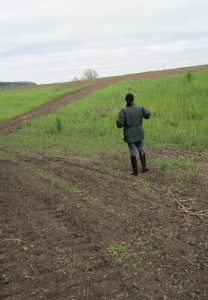 That hill of land fill that no one really knows where it came from was done without an approved site plan. The city had to go to court to force the Air Park owners to comply. They have yet to do so. By-Law Enforcement Service: Over 75% of respondents indicated the name was suitable and slightly less than 70% of respondents indicated the description was suitable. When asked to place the service into a category, less than 50% of respondents selected the Public Safety category, while over 25% of respondents selected the Local Government Support category. Three respondents’ comments indicated this service should be merged with Parking Management Service.
Emergency Management Service: Close to 75% of respondents indicated the name and description were suitable. When asked to place the service into a category, more than 70% of respondents selected the Public Safety category. Two respondents’ comments indicated the name was unclear.
Fire Protection Service: Over 85% of respondents indicated the name was suitable and almost 75% of respondents indicated that the description was suitable. When asked to place the service into a category, more than 90% of respondents selected the Public Safety category. Two respondents’ comments indicated the description was unclear.
Halton Court Service: Over 65% of respondents indicated the name and over 70% of respondents indicated the description was suitable. When asked to place the service into a category, less than 55% of respondents selected the Local Government Support category, while over 20% selected the Public Safety category and another 20% of respondents indicated it did not fit into a category. Two respondents’ comments indicated Halton Court Service did not fit into a category and three respondents’ comments indicated the name was vague.
Roads & Transportation Category:
Roads and Structures Design & Construction Service: Less than 70% of respondents indicated the name and description were suitable. When asked to place the service into a category, slightly less than 60% of respondents selected the Roads & Transportation category, while approximately 35% selected the Design & Build category.
Parking Management Service: Slightly over 80% of respondents indicated the name was suitable and slightly over 75% indicated the description was suitable. When asked to place the service into a category, over 60% of respondents selected the Roads & Transportation category. Three respondents’ comments indicated this service should be merged with By-Law & Enforcement Service.
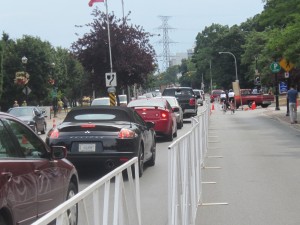 Traffic barriers in place on LAkeshore for the Car Free Sunday last year were expensive and not really used. The event was poorly attended. An opportunity for better traffic management. Traffic Operations Service: Over 60% of respondents indicated the name and over 65% of respondents indicated the description was suitable. When asked to place the service into a category, over 65% of respondents selected the Roads & Transportation category, while 20% selected Public Safety category. Five respondents’ comments indicated the name was unclear.
Transit Service: Over 80% of respondents indicated the name and over 75% of respondents indicated the description was suitable. When asked to place the service into a category, slightly less than 85% of respondents selected the Roads & Transportation category.
Transportation Planning Service: Slightly less than 65% of respondents indicated the name and slightly less than 60% of respondents indicated the description was suitable. When asked to place the service into a category, more than 65% of respondents selected the Roads & Transportation category, while over 20% of respondents selected the Design & Build category. Four respondents’ comments indicated the description was unclear.
 One of the more than 25 pieces of equipment out clearing the primary roads – on this day they were out at at 3 am. Winter Control Service: Over 70% of respondents indicated the name and over 80% of respondents indicated the description was suitable. When asked to place the service into a category, less than 50% of respondents selected the Roads & Transportation category, while over 30% of respondents selected the Maintenance category. Seventeen respondent comments specifically indicated winter cannot be controlled.
This is what your city does for you. In a couple of months they will tell you how much of your money they want to pay for these services.
The budget that is presented for 2015 will be quite a bit different than what the public saw for 2014. The Gazette will report on all the changes.

 By Pepper Parr By Pepper Parr
November 15, 2014
Burlington, ON
She does it differently.
We get to many, but not all, of the local meetings Council members hold and while they each have their own style, ward 2 Councillor Marianne Meed Ward does do something uniquely different. She listens, she coaxes answers out of people and – yes she still talks too much. But her people – and those that show up are very much her people; like her and they trust her.
 Thursday evening the community meeting was about a condominium project basically across the street from the Performing Arts Centre wrapped around what is currently the Melodia restaurant. City hall is across another one of the three streets that border this project. Thursday evening the community meeting was about a condominium project basically across the street from the Performing Arts Centre wrapped around what is currently the Melodia restaurant. City hall is across another one of the three streets that border this project.
Zoning for the property is four storeys – and that zoning is specific to the property. The developer wants to add an additional floor and is asking for a change in the zoning and the Official Plan.
Meed Ward tends to personally oppose this kind of change in both zoning and the Official Plan. She argues that it is not the city’s job to make changes in zoning so that a developer can gain additional density and this a higher return on their investment.
Zoning on the property:
Permits high density residential, office & commercial uses
Permits density between 51 & 185 units per hectare
Retail uses required at grade
No surface parking permitted
Min. height 2 storeys – max. 4 storeys
Other Downtown Core sites allow up to 8 storey height through rezoning.
This area has a specific policy restricting height to 4 storeys to maintain compatibility with residential uses to the north and west
Meed Ward tends to look for trade-offs – in return for the additional density she looks for some form of contribution to the city. It can be public art or an amenity from which the public will benefit.
The fifth floor in the design is set back by about three metres on each side so that it doesn’t add to the perceived height of the building. What wasn’t stated at the meeting was that the mechanical equipment will be on top of the fifth floor; adding a bit more height.
The design is both traditional and classic in looks with detailing to be done in stone and brick. There will be bay windows in each unit with balconies built into the side of the structure and not hanging out on the side of the building.
Whenever a developer asks for a change local residents bring up the old setting a “precedent” argument and developers do try to exploit that when they are looking for a change in the rules.
City planner Bruce Krushelnicki tirelessly tells people that a change made in one location does not mean the same change is going to be permitted elsewhere. Planners ask one question: Is this a good plan and if, in their judgement it is good planning , they say so in their staff report. Have they made mistakes in the past? You bet your ‘bippy’ they have – the Ghent Street development was a serious mistake that we predict history will prove to have been wrong.
The re-development would be a fine addition to the downtown part of the city. Some suggested that allowing five stories would put pressure on the single storey and two storey dwellings in the neighbourhood – and it will. Many of the properties on Locust do not make economic use of the land they site on. Some of the properties are historic in nature and have to be preserved and the Heritage Advisory committee will be asked for an opinion on their historic credibility. One of the structures used on the property that was purchased by the developer used to house the Blair Lancaster Spa – while the building is on the Registry it is hard to see much in the way of historic value to the structure. It actually looks a little shabby.
The Core District group which keeps a close eye on development in their immediate neighbourhood and everything in the ward is good at getting the troops out to oppose projects. It would be a large step forward if they moved beyond just opposing and got into some serious thinking about what they want their neighbourhood to look like 5, 10 and 20 years out.
 Ken Greenberg told Burlingtonians in 2012 that they could have much more input if development proposals brought to the city if they organized. Noted planner Ken Greenberg was in Burlington in April of 2012, as part of the Mayor’s Insight series of events – one of the better things the Mayor did in his first term of office. Greenberg explained that it is possible for the residents of a neighbourhood to set out their basic principles and invite any developer with plans to meet with them.
That is a part of what happened Thursday evening but that event was organized by the ward Councillor – the residents themselves need to take control.
The architect and the developer that met with the public Thursday evening appeared to be quite willing to accommodate the audience. They have yet to take an application to the planning department. They were convinced to meet with the residents in the community – about 50 people attended and they listened. They will now go back to their drawing boards, perhaps make some changes and submit their application. They have bought and paid for the property so they have sin in the game.
The developer said that they usually build one bedroom units but that real estate people in Burlington advised them that the market wanted two bedroom size units. One parking space for each unit and ¼ of a parking space for each unit to accommodate visitors.
 The proposed development is two blocks north of this intersection. Adding a fifth storey to the proposed building is not going to change the texture or feel of the neighbourhood. When built – the structure will add dignity and grace to the streetscape. There really wasn`t much to complain about with this project. The chatter in the Gazette`s comments section based on a piece we published telling people about the meeting had these words: One said: “I do however like the design and the extra story is stepped back nicely and does not appear to be detrimental. If I’m a resident, I’d rather be near a high-quality 5 story building, than a cheapo 4 story building. Or a parking lot that a developer is sitting on in hopes of building something big for that matter. Hopefully they can get this done whether it happens to be 4 stories or 5 stories is not really the most important issue.”
Peter Rusin, a candidate for Mayor said: “This site is actually quite suitable for an 8-storey redevelopment. There is no reason for any of the old Meed Ward crazy type of resistance; that negative philosophy increases taxes for everybody, keeps unwanted upward pressure on housing price increases for everyone, and kills downtown businesses that hope to rely on more people living in the core. I just hope the old Meed Ward mentality changes in the new term of council. I hope she does her math homework; this assignment is easy. Go to eight stories and encourage even more intensified projects; The future of Burlington depends on it.”
Another astute observer made this comment: “The main difference between Ms. Meed Ward’s point of view and Mr. Rusin’s is that the electorate supported the former and rejected the latter.
A principle of good planning is that we establish a plan and be extremely prudent about changing it. I don’t believe we owe developers the “right” to make a living.
This is a good development. It will be pricy but there will be quality sticking out of every corner. We will be lucky to get it. At least that is my take.
Related content:
What Ken Greenberg had to say about involving the community.
Initial response to the project was divided.

 By Staff By Staff
November 14, 2014
BURLINGTON, ON
Halton Regional Police have completed their month long firearms and weapons amnesty. It is evident our communities in Halton are that much safer due to the partnership between the community and police.
Between October 15 and November 15, 2014, Halton officers took in approximately 180 firearm were turned in, approximately 40 knives and 200 pounds of ammunition.
Police invited people with a firearm to turn it over to police who would destroy the weapons. When the announcement of the amnesty was made police cautioned anyone asking to have a weapon picked up to:
DO NOT BRING ANY WEAPONS OR FIREARMS TO A POLICE STATION.
DO NOT TRANSPORT FIREARMS OR WEAPONS IN YOUR VEHICLE.
DO NOT GREET OFFICERS AT THE DOOR WITH FIREARMS/WEAPONS.
Officers assigned to pick up the weapons“ said the announcement will provide police identification and will require a signature for destruction. They added that “This Amnesty is an opportunity for everyone to take part in removing these firearms and weapons from the community, reducing the risk of them falling into the hands of criminals.`
Today there are 180 fewer guns in the community.
The police make as much use of photo-ops as the politicians and have invited media to attend a photo opportunity at HRPS Headquarters, 1151 Bronte Rd, in the Town of Oakville on Monday November 17th at 10:00am in the Community Room.
Related story:
Police offer an amnesty to owners of guns and other weapons

 By James Smith By James Smith
November 13, 2014
BURLINGTON, ON
I remember this past Tuesday. I’m standing in my office staring at the framed memento, almost 100 years old. A thing I’ve looked at and read countless times; “In the Service of the Nation”. Standing silently I read the names of the engagements: Chateau Thierry, Soissons, Argonne. Argonne, where he received his Purple Heart. The Purple Heart is framed and kept by one of my brothers, now retired from the American Military.
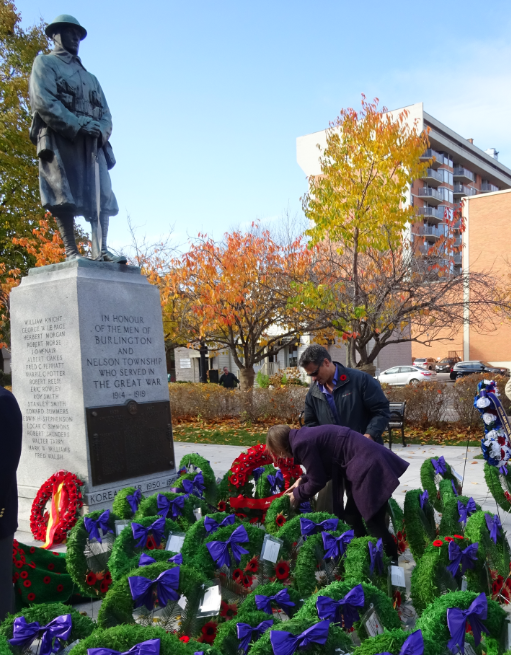 I remember. I remember being a child, holding the medal in my hand and can still feel how heavy & cold it was. How odd to touch the engraved name, the same name as me. I can now hear the TV downstairs again. Two minutes are up, all over, go back to what you were doing. Except I keep thinking of him, his easy smile, the shock of thick white hair, the soft voice that gave his birthplace away despite decades of life in Hell’s Kitchen. He’d never talk about the war, we kids would press but he’d cloud over and say something like “The park is no place to talk of such things”. The most he would ever say is that it was a quick way to become a REAL American. I remember. I remember being a child, holding the medal in my hand and can still feel how heavy & cold it was. How odd to touch the engraved name, the same name as me. I can now hear the TV downstairs again. Two minutes are up, all over, go back to what you were doing. Except I keep thinking of him, his easy smile, the shock of thick white hair, the soft voice that gave his birthplace away despite decades of life in Hell’s Kitchen. He’d never talk about the war, we kids would press but he’d cloud over and say something like “The park is no place to talk of such things”. The most he would ever say is that it was a quick way to become a REAL American.
I remember his funeral. I was just old enough to know that Vietnam was starting to go badly and my own childhood notion of going to America and joining the US Marines was starting to fade as a real goal. The flag draped coffin and the honour guard suddenly seemed very scary to a ten year old. I almost cried in shock when the rifle volleys sounded. The folded flag presented to my Grandmother made me think of what I had been seeing on the TV and the young men being killed in Vietnam.
I remember looking at the Empire State Building in the distance as we made our way back to the limousine and thinking as sad as I was, what would it be like if this was one of my cousins? What if it was my dad being lowered into the ground? I’ve sometimes thought back to that springtime week in New York as the time when I started to wonder about such things that Edwin Starr would sing about a few years later in his song WAR!
I remember the following November and learning to recite In Flanders Field (I still can by the way). At the Remembrance Day assembly not only did I recite John McCrae’s Poem but I introduced the speaker. A First World War Vet, a kindly and grandfatherly gentleman. He kept me on stage to hold his tin hat after I introduced him. The helmet had an odd slice in the back flange, I put my fingers in the hole as I nervously continued to stand on stage, the slash in the steel felt cold and jagged and I wondered about the hole.
Our guest spoke not about war, but about the peace that he hoped we had gained through the horror of three wars. He told us of his wish that peace would fill our days so us kids would never have to see any of the horror that he, and my late Grandfather did. As he concluded his address he took a piece of metal out of his pocket and said how luck he was to be speaking to us and had me hand him his helmet back. With this nasty chunk of metal in one hand and the helmet in the other, he neatly locked the shrapnel into the hole in the tin hat. The audience gasped. After the assembly at recess I was briefly a cool kid because I had held this army helmet, but I recall being somewhat confused by the experience. I still am.
I remember and honour those who’ve served and those who’ve died and respect those who still continue to wear the uniform. I think all Canadians are a little more mindful and respectful this November after the killing of Warrant Officer Patrice Vincent, and Corporal Nathan Cirillo. But war should never be an option until every other option has been tried and found wanting. Since the Korean War Canada has a proud history of Peace Keeping, a tradition that some would have us move away from. In fact we have very few remaining Peacekeepers in this world and I don’t like this trend. I think my grandfather and others of his generation would tend to agree with me.
 In their book WARRIOR NATION: REBRANDING CANADA IN AN AGE OF ANXIETY, Ian McKay and Jamie Swift talk about the “New Warriors” who are “looking to shift public opinion.” They speak of “zealots” who would “transform postwar Canada’s central myth-symbols. Peaceable kingdom. Just society. Multicultural tolerance. Reasoned public debate.” They would replace these traditions with “A warrior nation. Authoritarian leadership. Permanent political polarization.” Vimy Ridge it seems is more important than Baldwin and LaFontaine, MacDonald and Cartier, Laurier and the settling of the west or many other achievements. In their book WARRIOR NATION: REBRANDING CANADA IN AN AGE OF ANXIETY, Ian McKay and Jamie Swift talk about the “New Warriors” who are “looking to shift public opinion.” They speak of “zealots” who would “transform postwar Canada’s central myth-symbols. Peaceable kingdom. Just society. Multicultural tolerance. Reasoned public debate.” They would replace these traditions with “A warrior nation. Authoritarian leadership. Permanent political polarization.” Vimy Ridge it seems is more important than Baldwin and LaFontaine, MacDonald and Cartier, Laurier and the settling of the west or many other achievements.
A battle in a useless war is now being spoken of as what “made” Canada. This trend troubles Messrs McKay and Swift enough they’ve written a book, and this trend fills me with an empty feeling. The first world war was a war between Empires that was foolish, brutal, stupid and avoidable. As a colony Canada was involved because we had no choice. That men fought, and fought bravely should be remembered, but so should the fact that it wrecked and bankrupted Europe and set the table for Fascism and Stalinism and the further horror that was the second world war. That we should say our nation “came of age” because brave men killed other brave men in a war that we had no say in seems to me to the acme of jingoistic nostalgia for the good old days of Red Ensigns and Rule Britannia not the foundation of the amazing country we live in today.
I remember an all but forgotten monument on University Avenue in Toronto. You’ve likely seen it, just north of Queen Street, it’s the memorial dedicated to those who died in the Boer War. The monument features two heroic young Canadian lads marching off to do battle. As they look to the middle distance, they march in the direction a young Britannia is pointing to.
Whenever I see this monument it always make me think she’s saying: “Go! Go forth & defend the Empire good lads! Africa must be free of the evil Dutch farmers and safe for gold & diamond mines and to build Apartheid! GO my lads GO!” It is a lonely and sad monument that seems to be forgotten. Many men fought bravely for Queen and Empire, four Victoria Crosses were awarded to Canadians in that war. Given the precedent of this forgotten monument why not dust that off too and say Canada was born on the Veldt at Paardeberg rather than Vimy Ridge? I say it’s just as relevant.
 I remember visiting Sarajevo. Back when it was still Yugoslavia and I stood on the spot where Franz Ferdinand and his wife Sophie were assassinated. The spot where the match was struck that started the Great War, and it seemed so ordinary and almost shabby. How did such a quaint and diverse city, an Olympic host city later become a place of such carnage in the Bosnian war? I bet I know part of the reason. Hate. Intolerance. Envy. Authoritarian Leadership. Political Polarization. Military Zealots. I remember visiting Sarajevo. Back when it was still Yugoslavia and I stood on the spot where Franz Ferdinand and his wife Sophie were assassinated. The spot where the match was struck that started the Great War, and it seemed so ordinary and almost shabby. How did such a quaint and diverse city, an Olympic host city later become a place of such carnage in the Bosnian war? I bet I know part of the reason. Hate. Intolerance. Envy. Authoritarian Leadership. Political Polarization. Military Zealots.
We need to rid our landscape of such things. That the military will always be a large part of Remembrance day goes without saying. But we need to always ensure that our Remembrance Day ceremonies do not become jingoistic celebrations of conflict. The reason we remember those who served and who have fallen is to also reflect on the Peace and what is left of our Freedoms due to the service and the sacrifice of so many. We lose these freedoms through our complacency and acceptance of what the generals want.
Just to let you in on a teeny weeny secret; since at least the time of the Sumerians, the Generals have never had enough toys, and they always want to play with their toys.
I remember in the 1970’s some wag saying “rather than declare war on a little country, we should declare Peace on all countries”. I’d like to suggest we take this idea up and start a new tradition for our next Canada Day; two minutes of silence while we think about what we can do for Peace in our homes, workplaces, cities, provinces and our country. Perhaps then we can build a world that’s more like what my Grandfather would have liked to think that his service helped to build.
James Smith is an architectural technologist who dabbles in politics and has been described as an essayist. The above is his most recent pondering.


By Ray Rivers
November 13, 2014
BURLINGTON, ON.
Maybe it was that melodic voice wafting through my car speakers. Or maybe the sense of command and confidence projected by this smooth talk show host, drilling down to get at the nut of each issue. I loved listening to Jian Ghomeshi and his well-honed ‘Q’ show which had risen to the peak of radio fame just in time for his dramatic tumble into disgrace, having been exposed as a closet misogynist, a woman beater.
Ghomeshi the radio host always seemed such a gentle and sensitive individual. Who would have guessed ‘Norman Bates’ might be lurking somewhere in his imagination. It wasn’t stabbing in a shower, but it was dangerous spontaneous choking and beatings. It is hard to believe that the man who crafted such a passionate and sweet tribute to his father, on his passing, could have been harbouring such a monster within.
And it wasn’t just the dating, but also his overbearing management style, that did him in. He had become the face of CBC radio, he disgraced himself and fell, as Shakespeare would have applauded – by his own devices. In this case it was his own violent hand. Yet there was an upside to this tragic story since it encouraged so many victims to spring forward for an emancipation of sorts, a new freedom to come forward and tell all.
We were treated to exposés by Ghomeshi’s former dates, his staff and his bosses at CBC, as they described his tyrannical, obsessive and demanding management style. And those stories, no doubt, seemed to encourage a couple of NDP MP’s to complain to Justin Trudeau presumably about a couple of his Liberal MPs hitting on them – or hitting them – we don’t know. Trudeau immediately suspended them from his caucus pending an investigation, only to be verbally abused by an angry NDP leader Mulcair.
Perhaps Mulcair was annoyed that his caucus members had gone to Trudeau instead of to him. Or maybe he was trying to draw cover for an impending harassment case between one of his own MPs and an office staffer. Then out of the blue Sheila Copps comes forward to tell all about an attempted assault by an MP during her time on the Hill, and adding that she had also been raped some years earlier.
All this coming-out makes one wonder who is next, and when will enough be enough already. And what is wrong with our elected federal representatives that they have to act like mischievous children while pay them to represent us in Ottawa. That is not how I want to be represented, perhaps we need an age limit.
We know that bullying behaviour starts early in life. Some would argue that It is a natural phenomenon, development of a ‘pecking order’ sort of thing – in a dog-eat-dog world where the strong survive and weak just suffer – where the cave man goes out to kill the bear and his favourite squeeze stays home to raise the babies and tend to the fire.
 But that isn’t how our modern great society works. We demand equity, equality of opportunity and respect for human dignity; and we expect personal freedom regardless of gender, physical size or economic endowment. So we have started teaching children not to bully, intimidate, or harass, from an early age. That is the way we want them to behave in a civilized community, even if their parents don’t. But that isn’t how our modern great society works. We demand equity, equality of opportunity and respect for human dignity; and we expect personal freedom regardless of gender, physical size or economic endowment. So we have started teaching children not to bully, intimidate, or harass, from an early age. That is the way we want them to behave in a civilized community, even if their parents don’t.
I can recall being at an official function a few years ago when one of my bosses came over and surprised me by squeezing my arm until it hurt. I yelled ‘ouch’ thinking she must have wanted to get my attention – and that sure did the trick. I might have made a formal complaint instead of just brushing off the incident, but like so many others I was a little embarrassed, so let it pass.
I consider myself a tactile person. I believe there are times, especially when grief or joy are upon us, that we humans need the assurance of another’s touch. Life would be so incomplete were society to ban physical contact entirely in the name of preventing potential assault. But touching does have its limits – hurting someone, spontaneously choking or punching them about the head is a whole different kettle of worms.
‘Q’ will stay on the air with a new executive producer and a new host, but for me it’ll never be the same without the brilliant Ghomeshi. I remember back to a time when an extremely hostile guest, Billy Bob Thornton, tore into Jian for the way he was interviewing. Billy Bob backed him into a corner and humbled him into an embarrassing submission. No, it wasn’t violence, but Jian Ghomeshi must have got a good taste of what it was like to be on the receiving end of bullying. Too bad he didn’t learn from that experience.
 Ray Rivers writes weekly on both federal and provincial politics, applying his more than 25 years as a federal bureaucrat to his thinking. Rivers was a candidate for provincial office in Burlington where he ran against Cam Jackson in 1995, the year Mike Harris and the Common Sense Revolution swept the province. Ray Rivers writes weekly on both federal and provincial politics, applying his more than 25 years as a federal bureaucrat to his thinking. Rivers was a candidate for provincial office in Burlington where he ran against Cam Jackson in 1995, the year Mike Harris and the Common Sense Revolution swept the province.
Background links:
Ghomeshi Ghomeshi Scandal Trudeau MPs NDP Staffer
Sheila Copps Billy Bob Interview Sexual Consent
Bullying Stop a Bully What’s Harassment
Dealing with Sexual Misconduct

 By Pepper Parr By Pepper Parr
November 12, 2014
BURLINGTON, ON.
Can someone really change the world with a giving heart?
The Association of Fundraising Professionals (AFP), will tell you people can, through the giving of one’s time, talent or treasure, make a significant difference.
Seven philanthropists and organizations from the AFP Golden Horseshoe Chapter will be recognized for their commitment to supporting and inspiring philanthropy in their communities through the 7th Annual National Philanthropy Day (NPD) awards presentation. Two of these outstanding people are Burlington.
National Philanthropy Day® is set aside to recognize, and pay tribute to the great contributions that philanthropy – and those people active in the philanthropic community – have made to our lives, our communities and our world. Each year, AFP honours individuals and groups who, through their hard work and dedication, have enhanced and inspired philanthropy locally and around the globe.
National Philanthropy Day is officially recognized by the Government of Canada’s National Philanthropy Day Act. This acknowledges the important role philanthropy plays in building strong communities, promoting civic engagement and improving the lives of Canadians through the work of caring individuals and charitable organizations.
“We are celebrating those who have made significant contributions to philanthropy,” explains Roger Ali, President of the AFP Golden Horseshoe Chapter. “Volunteers, donors and fundraisers, and their dedication to doing good works for charities and causes within our regions is an inspiration to all of us,” he adds. “And we are part of something much broader; we share this day with some 50,000 people in more than 100 communities and around the world who are paying tribute to National Philanthropy Day in many distinct ways. I extend congratulations to all the award winners!”
Outstanding Volunteer Fundraiser – Susan Busby: Nominated By: Joseph Brant Hospital Foundation
Not only has Susan Busby’s personal giving been instrumental to the success of ensuring state-of-the-art health services for our community, her volunteer contributions are equally inspiring as an active and valued member of the Joseph Brant Hospital and the Foundation’s Boards. She served as Chair of Board of Directors, Volunteer Governor, member of the Ambassadors Council and Campaign Cabinet member, just to name a few.
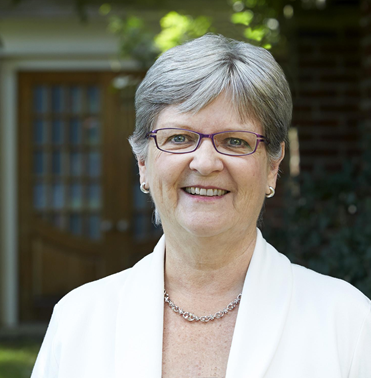 Susan Busby; recipient of the 2014 Association of Fundraising Professionals Outstanding Volunteer award.
Susan is a true champion of children and youth in need. As a former teacher and principal, Susan recognized the importance of student success and achievement and dedicated her time to build the Halton Learning Foundation. Her involvement with the Nelson Youth Centres provided tremendous leadership as a tireless advocate and fundraiser. Through annual fundraisers she helped raise the profile of the organization in the community to support children’s mental health programs.
Susan exemplifies the true spirit and best qualities of our community. Her leadership and passion for engaging others to give truly represents philanthropy and the positive impact others can make in their community.
Outstanding Volunteer Fundraiser – Ron Foxcroft; Nominated by: Hillfield Strathallen College
Affectionately known as “Mr. Hamilton”, Ron Foxcroft is a passionate advocate for causes involving children and a healthy community, as well as a highly successful entrepreneur. In Ron’s words: “Building healthy bodies and minds makes for a stronger community. Recreation leads to a lifetime of better health, self-esteem, leadership and teamwork skills.”
 Ron Foxcroft; recipient of the 2014 Association of Fundraising Professionals Outstanding Volunteer award. Ron has a steadfast belief that anything is possible with hard work, determination and the support of dedicated volunteers. He has an unwavering commitment to his philanthropy, the Hamilton/Burlington communities, and his untiring volunteerism. Ron never hesitates to use his broad network of connections and relationships to engage others and help him achieve his goals.
Over the years, he has been committed to a broad range of local causes including: McMaster University, St. Joseph’s Healthcare, Hillfield Strathallan College, Mohawk College, Hamilton Community Foundation, Big Brothers Big Sisters, McMasters Children’s Hospital and City Kidz, just to name a few. Countless individuals and organizations have benefitted from his volunteerism and he is an incredible inspiration and role model for leadership and generosity.
The above is what the Association of Fundraising professionals had to say about Busby and Foxcroft. Here’s the real skinny on those two. Susan Busby will tell you that she has a saint of a husband who has been beside her every step of the way – and then some. Marie, Ron Foxcroft’s wife will tell you that she gave up trying to keep up with Ron. She’s happy when he gets home.
You could not find two people more unlike each other than Foxcroft and Busby. Busby uses her skills as a high school principal to let people understand how something should get done. She has that remarkable ability to let people figure out what she has in mind – and then she helps them get it done.
During her various assignments at the hospital Busby had to deal with people who had very healthy egos; she dealt with those egos very effectively, a testament to her length of service to the hospital and the wider community.
Foxcroft is a little more aggressive. He twists arms – nicely – but you know your arm is being twisted and if you’ve been around Burlington at all – give in when he calls.
Ron is the kind of guy who can keep a secret but he does that a little differently than most of us. He tells you the secret and makes you promise not to pass it on – and then he holds you to that promise.
Mayor Goldring called Ron Foxcroft when he needed help with raising funds for Flood Disaster Relief. Foxcroft had cheques on the table before the end of the week and began going through his Rolodex and making calls.
He set an ambitious target and then did a number on the provincial government to ensure that they too came through with the commitment Burlington needed. MPP Ted McMeekin, responsible for the Flamborough to the west of us was also the Minister who would have to sign off on the funding.
McMeekin got the Foxcroft treatment for three solid days – the man may never be the same. But earlier this week the local MPP’s, Indira Nadoor-Harris and Eleanor McMahon announced that the provincial government would provide up to $3 million to Burlington on a two-for-one basis; for every dollar we raised the province would add two dollars.
Ron Foxcroft didn’t start making calls during the media event at which the announcement was made – but he was on the phone while driving home – a hands free phone.
Fund raising ends on Friday, the evening Foxcroft and Busby are to be recognized. Will Ron walk from table to table asking for cheques – and has he put the touch on Susan Busby yet?
Two fine people being recognized for decades of personal philanthropy – kudos to the two of them.

 By Mark Gillies By Mark Gillies
November 10, 2014
BURLINGTON, ON.
The first news about the loss of a soldier who lived in Burlington was a telegram from Ottawa. That telegram would have come through the railway station that the men board the train to Toronto on.
 Edward Cooper Simmons My grandfather served in that war. He wasn’t one of the of the 300 men from Burlington but he was part of that cohort that volunteered to fight in the first Great War. They believed it was the war that was going to end all wars.
Burlington was a town with a population of less than 2000; it sent more than 10% of its population off to fight a war that was on the other side of the world. everyone in town knew some of these men.
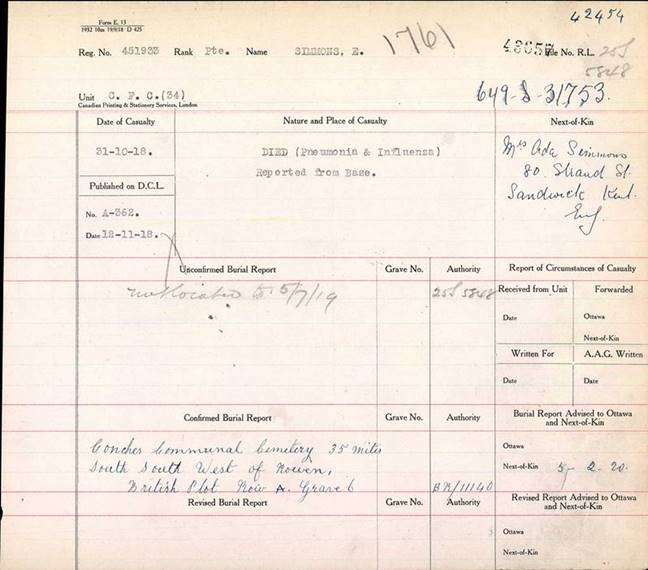 The Army Death detail document tells us Private Simmons died if influenza and pneumonia in the field. We are given the name of the cemetery his remains were laid to rest in. One of the those men was Edward Cooper Simmons. He died in the field of influenza and pneumonia.
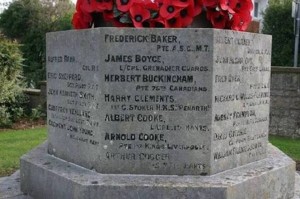 Buckingham’s name is on a small cenotaph elsewhere. Shown is a closeup of the names. There is the name of a seaman as well. Robert John Buckingham was killed in action on May 30th, 1918 at a battle south of Sancourt. The Army death documentation says where he was buried. That is all that exists in the way of documentation but along with his name there is a tombstone with Robert John Buckingham’s name on it.
 Some detail taken from the Gazette, which at the time was the newspaper for the town. Note the easy, almost colloquial style. The Allen’s were a very prominent Burlington family. They owned a hardware store that was on Brant Street – not far from where Burlingtonians will gather on Remembrance Day. Joseph E. Allen was one of the 38 that left for the war and did not return. As a boy Joe surely walked by the place the cenotaph now stands. The short news item in the Gazette told of an injury. Allen later died of that injury.
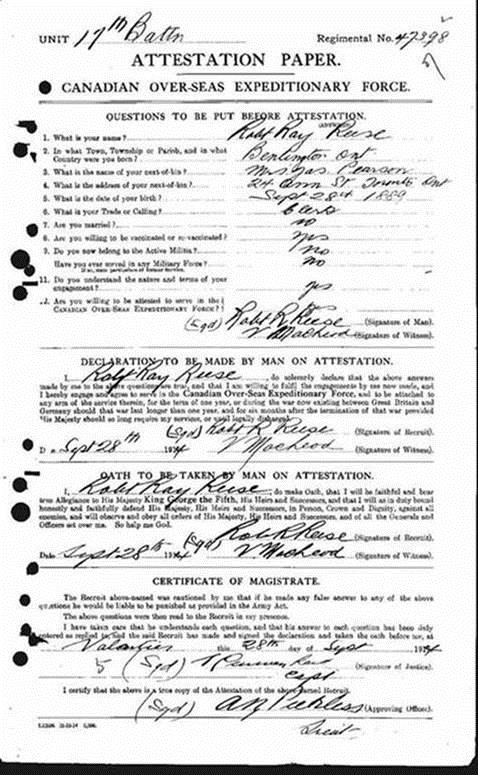 The phrase “sign-up” refers to this document which the Militia called an Attestation Paper. Private Reese was Killed in Action in a battle at St. Julien on April 28, 1915. The documents tell us little more than that. When men enlisted they completed what was known as an Attestation form that set out the information the government needed. The department that handled all the paper work was called the Militia Department.
Robert Ray Reese was part of the Canadian Over-seas Expeditionary Force. He signed an Oath that was then signed by the local magistrate. His next of kin lived in Toronto. Reese was single. There was an Attestation form for every man that “signed-up”
 There wasn’t a lot of information available on Private Albert Oakes. Albert Oakes died in the same action as Private Reese. The battle at St. Julien took at least two men from Burlington. They died days apart on the same battlefield. All we have in the way of records is the Army death detail document.
Harry George Bracknell was at first thought to be missing. The documentation says he was later presumed to be dead while fighting in a battle on Hill 60 in Belgium. The document was signed by General Murray Maxwell.
 Harry George Bracknell – Very few details, missing, presumed dead. Thousands of men were blown to piece by shells that landed close to where they were standing. There were no remains to bury – just a document saying they had been lost. All we have is a name on a cenotaph in Burlington.

 By Pepper Parr By Pepper Parr
November 6, 2014
BURLINGTON. ON.
Local government works best when the people in the community play a meaningful role in the determination of what the tax rates should be and what the money raised is to be spent on.
Bureaucrats can`t do it all. In Burlington, many of the senior people don`t live in the city 0- their relationship with citizens is for the most part paper based and interactions at committee or Council meetings.
Burlington has a number of Advisory Committees – some work exceptionally well while others are a mess. This reporter has sat in on two Advisory Committee meetings where members were throwing copies of reports at each other.
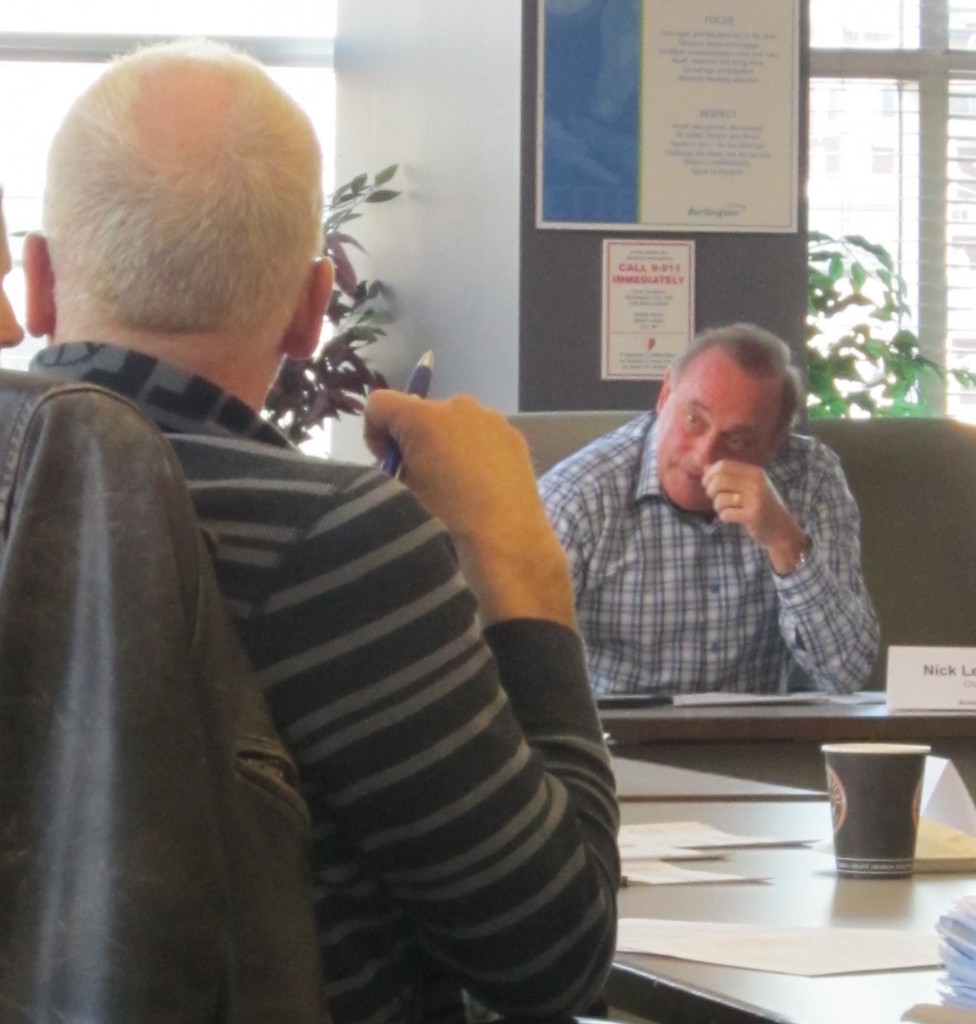 Nicholas Leblovic. chair of the now sunset Waterfront Advisory committee. Some Advisory Committees work well – others don’t. The city has created Advisory Committees and shut them down before they completed a full term; that was the fate of WAPA – the Waterfront Access and Protection Advisory committee that was the starting point for that startling decision of the Council that will end its tem at the end of the month.
There are Advisory Committees that do superb work – better than staff people at city hall. And there are Advisory Committees that are poorly chaired.
Who sits on the Advisory Committees?
The city runs advertisements asking for people to submit an application; they are reviewed, people are interviewed and the selections announced. The decisions of city hall staff who make the recommendations then go to Council where they are approved. There have been occasions when Council decide not to approve a particular person – that kind of a decision gets made in a closed session.
Thus the final word on who sits on those Advisory Committees is made by Council – they want to keep the trouble makers out – or do they want to ensure they will get people who will support what Council wants to see done?
Do Council members put names forward?
There are people in this city that do not agree with some of the policies city Council puts forward and they would like to see some form or organized opposition in place.
While municipal governments do not follow provincial or federal party lines – there are people who would like to see something in the way of an organization that is not specific subject based.
 The Official waterfront advisory committee was shut down by the city – citizens thought it important enough to have a committee and formed something independent of city hall. The Burlington Library is working with the city this year to put on an event that will let people learn more about the different advisory committees. The event will include committees that are not part of the civic administration.
The event: An Introduction to Boards and Committees, takes place on November 19th at the Central Library – starts at 7:00 pm. Oddly enough it doesn’t appear on the Library calendar and the city hasn’t said a word about it publicly. Disapointing.
The city has since advised that the event is n the city web site and that paid advertising is to appear soon.
While a large part of the city population lives south of the QEW – there are a lot of people north of that stretch of pavement. Why isn’t an event like this held in Alton in the recreational complex up there? This would give the people north of Dundas and those to the immediate south a chance to really participate.
Among the Boards and committees that will have representatives at the event are:
Burlington Accessibility Advisory Committee
Burlington Cycling Advisory Committee
Sustainable Development Advisory Committee
Heritage Burlington Advisory Committee
Senior’s Advisory Committee
Inclusivity Advisory Committee
Mundialization Committee
Committee of Adjustment
Downtown Parking Advisory Committee
Burlington Public Library Board
Burlington Museums Board
Doors Open Volunteer Organizing Committee
Canada Day Committee Organizing Committee
Christmas Parade Committee
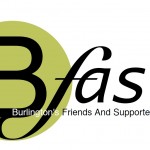 Bfast is an independent group that is well informed on transit matter. They delegate frequently. We understand that BFast (Burlington For Accessible Sustainable Transit) will also have a table for people who want to be involved in transit issues.

|
|
 By Pepper Parr
By Pepper Parr




































 If you are 15 – 18 years old and the answers to these questions are yes, maybe you’d like to check out the Halton Regional Police PEACE program!
If you are 15 – 18 years old and the answers to these questions are yes, maybe you’d like to check out the Halton Regional Police PEACE program! Bring your pen and pad, come with some ideas or just ready to write.
Bring your pen and pad, come with some ideas or just ready to write.
















 He was in Burlington Monday night as part of his book tour and demonstrated with his straight and candid talk why he was successful and progressive politician.
He was in Burlington Monday night as part of his book tour and demonstrated with his straight and candid talk why he was successful and progressive politician.








 Thursday evening the community meeting was about a condominium project basically across the street from the Performing Arts Centre wrapped around what is currently the Melodia restaurant. City hall is across another one of the three streets that border this project.
Thursday evening the community meeting was about a condominium project basically across the street from the Performing Arts Centre wrapped around what is currently the Melodia restaurant. City hall is across another one of the three streets that border this project.


 I remember. I remember being a child, holding the medal in my hand and can still feel how heavy & cold it was. How odd to touch the engraved name, the same name as me. I can now hear the TV downstairs again. Two minutes are up, all over, go back to what you were doing. Except I keep thinking of him, his easy smile, the shock of thick white hair, the soft voice that gave his birthplace away despite decades of life in Hell’s Kitchen. He’d never talk about the war, we kids would press but he’d cloud over and say something like “The park is no place to talk of such things”. The most he would ever say is that it was a quick way to become a REAL American.
I remember. I remember being a child, holding the medal in my hand and can still feel how heavy & cold it was. How odd to touch the engraved name, the same name as me. I can now hear the TV downstairs again. Two minutes are up, all over, go back to what you were doing. Except I keep thinking of him, his easy smile, the shock of thick white hair, the soft voice that gave his birthplace away despite decades of life in Hell’s Kitchen. He’d never talk about the war, we kids would press but he’d cloud over and say something like “The park is no place to talk of such things”. The most he would ever say is that it was a quick way to become a REAL American. In their book WARRIOR NATION: REBRANDING CANADA IN AN AGE OF ANXIETY, Ian McKay and Jamie Swift talk about the “New Warriors” who are “looking to shift public opinion.” They speak of “zealots” who would “transform postwar Canada’s central myth-symbols. Peaceable kingdom. Just society. Multicultural tolerance. Reasoned public debate.” They would replace these traditions with “A warrior nation. Authoritarian leadership. Permanent political polarization.” Vimy Ridge it seems is more important than Baldwin and LaFontaine, MacDonald and Cartier, Laurier and the settling of the west or many other achievements.
In their book WARRIOR NATION: REBRANDING CANADA IN AN AGE OF ANXIETY, Ian McKay and Jamie Swift talk about the “New Warriors” who are “looking to shift public opinion.” They speak of “zealots” who would “transform postwar Canada’s central myth-symbols. Peaceable kingdom. Just society. Multicultural tolerance. Reasoned public debate.” They would replace these traditions with “A warrior nation. Authoritarian leadership. Permanent political polarization.” Vimy Ridge it seems is more important than Baldwin and LaFontaine, MacDonald and Cartier, Laurier and the settling of the west or many other achievements.  I remember visiting Sarajevo. Back when it was still Yugoslavia and I stood on the spot where Franz Ferdinand and his wife Sophie were assassinated. The spot where the match was struck that started the Great War, and it seemed so ordinary and almost shabby. How did such a quaint and diverse city, an Olympic host city later become a place of such carnage in the Bosnian war? I bet I know part of the reason. Hate. Intolerance. Envy. Authoritarian Leadership. Political Polarization. Military Zealots.
I remember visiting Sarajevo. Back when it was still Yugoslavia and I stood on the spot where Franz Ferdinand and his wife Sophie were assassinated. The spot where the match was struck that started the Great War, and it seemed so ordinary and almost shabby. How did such a quaint and diverse city, an Olympic host city later become a place of such carnage in the Bosnian war? I bet I know part of the reason. Hate. Intolerance. Envy. Authoritarian Leadership. Political Polarization. Military Zealots. 
 But that isn’t how our modern great society works. We demand equity, equality of opportunity and respect for human dignity; and we expect personal freedom regardless of gender, physical size or economic endowment. So we have started teaching children not to bully, intimidate, or harass, from an early age. That is the way we want them to behave in a civilized community, even if their parents don’t.
But that isn’t how our modern great society works. We demand equity, equality of opportunity and respect for human dignity; and we expect personal freedom regardless of gender, physical size or economic endowment. So we have started teaching children not to bully, intimidate, or harass, from an early age. That is the way we want them to behave in a civilized community, even if their parents don’t.














